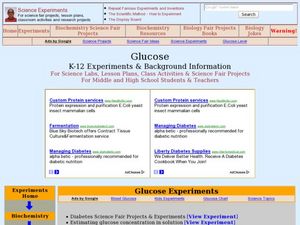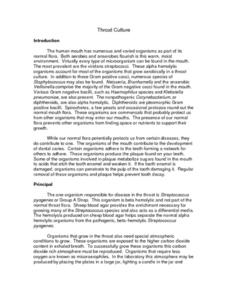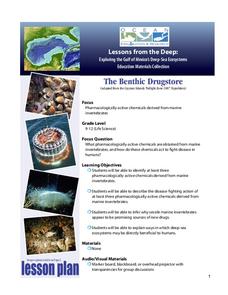Curated OER
Using Magnetotactic Bacteria to Study Natural Selection
Young scholars observe bacteria that are able to orient themselves using the Earth's magnetic field.They comprehend the difference between anaerobic and aerobic organisms. Students can tell the difference of the shape of magnetic force...
Gustavus Adolphus University
Five Physical Fitness Components
Five learning stations for five physical fitness components: cardiovascular exercise, body composition, muscle endurance, muscular strength, and flexibility. As pupils progress through each station, they will complete assigned tasks,...
Curated OER
Heart Smart in a Heart Beat
As an introductory activity, young statisticians measure their heart rate at rest and after exercise and compute the mean and median, and create a box & whisker plot. This is followed by watching a video (that no longer seems to...
K20 LEARN
Microbes and Manure = Biofuel
Waste not, want not! Science scholars explore manure as an alternative energy source through reading and experimentation. Groups construct their own biofuel digesters and observe the process of methane production. The teacher's guide...
Curated OER
Glucose
Learners conduct various experiments on glucose. In this biology instructional activity, students differentiate the process of diffusion and osmosis. They test different foods for the presence of glucose and starch.
Curated OER
Identification of Gram Negative Bacilli
In this biology worksheet, students review the procedures used to complete the lab activity and then examine the purpose and add the information while answering the questions.
Curated OER
Throat Culture
In this biology worksheet, students review the procedures used to complete the lab activity and then examine the purpose and add the information while answering the questions.
Curated OER
Respiration in Sammy's Cells
Students practice translating biological ideas into graphical representations and explore respiration in the context of an exercise session in this 50 minute lesson on aerobic and anaerobic respiration. The lesson includes a question...
Curated OER
Marine & Aquatic Habitats Activities - Terrestrial Forests vs. Kelp Forests
Students discuss concept and specificity of habitats, both marine and terrestrial, list similarities and differences in the habitats of a kelp forest and a terrestrial forest, compare types of organisms that occupy corresponding types of...
Curated OER
Breathing Victory
Students discuss anaerobic respiration and how it relates to sprinting. After discussion of related processes, students create a brochure that explains the complex processes behind every muscular interaction.
Curated OER
A Breath of Fresh Air! Oxygen Tolerance in Bacteria
Students explore and research what pork and beans, gangrene and denitrification have in common. They summarize that they all are the result of anaerobic bacterial action. Students analyze the chemical processes that are carried out by...
Curated OER
Exercise for the Heart
Third graders identify the relationship between physical activity and a healthy heart. Then they describe the long-term effects of daily physical activity on the heart. Students also distinguish aerobic from anaerobic exercises and ...
University of Southern California
Mastering Microbes
Small but mighty! Learners explore the role of microbes in a healthy ecosystem. An engaging lesson asks pupils to design an aquaponics system that demonstrates that healthy microbes are necessary to maintain the ecosystem.
Curated OER
De"compost"ition Activity
Students investigate the decomposition process and the parameters which influence the rate at which it occurs. They design a "controlled" experiment by comparing decomposition rates between two compost piles. Analysis questions include...
Curated OER
Got to Rot
Students make their own compost in a 2-liter jug and determine the actual volume loss in the composted material over a six-month period.
Curated OER
Fossil Formation
Students discuss fossils. In this science lesson, students simulate fossils within Earth's layers by using gummy fish and bread.
Curated OER
Biological Molecules
Ninth graders examine the structure and function of biomolecules. In this food molecule lesson plan, 9th graders will examine various types of biomolecules such as carbohydrates, lipids, proteins, and nucleic acids. They will analyze...
NOAA
Importance of Deep-Sea Ecosystems – The Benthic Drugstore
You never know what you will find next in the deep sea ecosystem. So far, scientists have found items that work as anti-tumor agents, anti-inflammatory agents, agents that stop uncontrolled cell division, and much more. The lesson begins...
Channel Islands Film
Human Impact on the Food Web of Santa Cruz Island
What happens when a non-native species is introduced onto an island? Santa Cruz Island, part of the Channel Island chain located off the coast of southern California, provides the perfect laboratory for young environmental scientists to...
NOAA
Importance of Deep-Sea Ecosystems – Chemists with No Backbones
Marine invertebrates offer us many new options for developing pharmaceutical drugs, such as w-conotoxin MVIIA, which is extracted from the cone snail and is a potent painkiller. The lesson encourages scholars to research various types of...
NOAA
Deep-Sea Ecosystems – Cool Corals
Young oceanographers research deep sea corals that thrive on chemosynthesis. The lesson focuses on the biology of the animal, preferred habitat, associations, and interactions.
Curated OER
A Design You’ll Dig: Designing a Habitat for Worms
Students discover how worms contribute to the balance of the environment. In this composting lesson plan, students study the composting and decomposition processes. Students then create habitats for worms that allow them to do their jobs.
NOAA
Deep-Sea Ecosystems – Entering the Twilight Zone
Imagine an ecosystem without any light or oxygen, where living things convert carbon dioxide into food. This ecosystem is thriving and might just be the largest ecosystem on our planet, yet we know very little about it. The instructional...
NOAA
Deep-Sea Ecosystems – Life is Weird!
A pool of brine in the deep sea can be up to four times as salty as the surrounding sea water. The deep sea ecosystem relies on chemosynthesis and the organisms that live there are often strange to us. The lesson plan focuses on...
Other popular searches
- Anaerobic Respiration
- Anaerobic Exercise
- Atp Aerobic Anaerobic
- Anaerobic Fermentation
- Anaerobic Digestion
- Aerobic Anaerobic
- Anaerobic and Aerobic
- Anaerobic Aerobic Exercise
- Anaerobic, Aerobic Exercise
- Aerobic, Anaerobic
- Atp, Aerobic, Anaerobic
- Anaerobic System

























